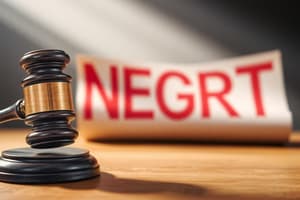Podcast
Questions and Answers
Which of the following best describes the primary distinction between tort law and criminal law?
Which of the following best describes the primary distinction between tort law and criminal law?
- Tort law is a subset of criminal law, dealing specifically with financial crimes.
- Tort law is a civil wrong that leads to compensation, and criminal law is a wrong against the state that leads to punishment. (correct)
- Criminal law aims to compensate the victim, whereas tort law seeks to punish the wrongdoer.
- Tort law addresses wrongs against society as a whole, while criminal law concerns private disputes.
In a negligence case, what is the significance of establishing a duty of care?
In a negligence case, what is the significance of establishing a duty of care?
- It confirms the defendant's intent to cause harm.
- It establishes a legal obligation for the defendant to act responsibly towards the plaintiff. (correct)
- It shifts the burden of proof from the plaintiff to the defendant.
- It determines the monetary value of the damages.
In tort law, even if the defendant owes a duty of care and breaches that duty, the plaintiff can still win the case even if they did not suffer any actual loss or damage as a result of the breach.
In tort law, even if the defendant owes a duty of care and breaches that duty, the plaintiff can still win the case even if they did not suffer any actual loss or damage as a result of the breach.
False (B)
Define the 'neighbour principle' and briefly explain its role in determining duty of care.
Define the 'neighbour principle' and briefly explain its role in determining duty of care.
In a negligence action, the plaintiff must prove duty, breach, __________, and causation to succeed.
In a negligence action, the plaintiff must prove duty, breach, __________, and causation to succeed.
Match the element of negligence with its description:
Match the element of negligence with its description:
What is the most common remedy sought by a plaintiff in a successful tort case, particularly in personal injury claims?
What is the most common remedy sought by a plaintiff in a successful tort case, particularly in personal injury claims?
The law of tort is considered public law, meaning the state decides whether to bring a case to civil court on behalf of an individual.
The law of tort is considered public law, meaning the state decides whether to bring a case to civil court on behalf of an individual.
Why is it crucial for a potential plaintiff to carefully consider the risk of losing a civil case, especially in tort law?
Why is it crucial for a potential plaintiff to carefully consider the risk of losing a civil case, especially in tort law?
__________ is an area of tort law that concerns damage to a person's reputation through false statements.
__________ is an area of tort law that concerns damage to a person's reputation through false statements.
Which of the following scenarios best illustrates a breach of duty of care in the context of negligence?
Which of the following scenarios best illustrates a breach of duty of care in the context of negligence?
If a defendant's breach of duty of care is proven, they’re automatically liable for all damages the plaintiff claims, regardless of foreseeability.
If a defendant's breach of duty of care is proven, they’re automatically liable for all damages the plaintiff claims, regardless of foreseeability.
Explain how the concept of 'reasonable foreseeability' is applied when determining causation in a negligence claim.
Explain how the concept of 'reasonable foreseeability' is applied when determining causation in a negligence claim.
The case of Donoghue v Stevenson established the __________ principle, fundamentally shaping the modern concept of negligence.
The case of Donoghue v Stevenson established the __________ principle, fundamentally shaping the modern concept of negligence.
Match the type of law with its description:
Match the type of law with its description:
Which of the following is NOT a category of civil law?
Which of the following is NOT a category of civil law?
If the defendant didn't intend to cause harm, they cannot be sued for negligence.
If the defendant didn't intend to cause harm, they cannot be sued for negligence.
Describe a scenario where the 'neighbour principle' might not easily apply, and explain why it creates a challenge in establishing duty of care.
Describe a scenario where the 'neighbour principle' might not easily apply, and explain why it creates a challenge in establishing duty of care.
In negligence cases, the term __________ refers to the financial compensation awarded to the plaintiff to cover their losses and damages.
In negligence cases, the term __________ refers to the financial compensation awarded to the plaintiff to cover their losses and damages.
Match the Law of Tort with an example.
Match the Law of Tort with an example.
In advanced tort litigation, concerning the element of causation, which legal principle most stringently challenges the establishment of proximate cause, requiring intricate analysis of intervening acts and their impact on the chain of causation?
In advanced tort litigation, concerning the element of causation, which legal principle most stringently challenges the establishment of proximate cause, requiring intricate analysis of intervening acts and their impact on the chain of causation?
In jurisdictions adhering strictly to the 'thin skull' rule, a defendant found liable for negligence must compensate the plaintiff for the full extent of their injuries, even if a pre-existing, unknown vulnerability of the plaintiff significantly exacerbates the harm beyond what an ordinary person would have suffered, thus potentially leading to disproportionately high damages.
In jurisdictions adhering strictly to the 'thin skull' rule, a defendant found liable for negligence must compensate the plaintiff for the full extent of their injuries, even if a pre-existing, unknown vulnerability of the plaintiff significantly exacerbates the harm beyond what an ordinary person would have suffered, thus potentially leading to disproportionately high damages.
Elaborate on the implications of the 'learned intermediary' doctrine in the context of pharmaceutical torts, particularly concerning direct-to-consumer advertising and the duty to warn.
Elaborate on the implications of the 'learned intermediary' doctrine in the context of pharmaceutical torts, particularly concerning direct-to-consumer advertising and the duty to warn.
The legal concept of ______ refers to a situation where the very nature of an accident implies negligence, thereby shifting the burden of proof to the defendant to demonstrate they were not negligent.
The legal concept of ______ refers to a situation where the very nature of an accident implies negligence, thereby shifting the burden of proof to the defendant to demonstrate they were not negligent.
Match the following legal doctrines with their respective definitions in the context of tort law:
Match the following legal doctrines with their respective definitions in the context of tort law:
Within the framework of negligence per se, what critical element distinguishes a statutory violation that automatically establishes breach of duty from one that does not, particularly in situations where the statute's primary purpose is debated?
Within the framework of negligence per se, what critical element distinguishes a statutory violation that automatically establishes breach of duty from one that does not, particularly in situations where the statute's primary purpose is debated?
In cases of pure economic loss resulting from negligence, without accompanying physical injury or property damage, recovery is generally permitted across all jurisdictions, provided that foreseeability of the economic harm is unequivocally established.
In cases of pure economic loss resulting from negligence, without accompanying physical injury or property damage, recovery is generally permitted across all jurisdictions, provided that foreseeability of the economic harm is unequivocally established.
Critically analyze the application of the 'rescue doctrine' in situations involving professional rescuers, such as firefighters or paramedics, and discuss the potential limitations or modifications necessary to account for their inherent occupational risks.
Critically analyze the application of the 'rescue doctrine' in situations involving professional rescuers, such as firefighters or paramedics, and discuss the potential limitations or modifications necessary to account for their inherent occupational risks.
The ______ test, utilized in determining factual causation, posits that a defendant's conduct is a cause of the injury if the injury would not have occurred but for the defendant's conduct.
The ______ test, utilized in determining factual causation, posits that a defendant's conduct is a cause of the injury if the injury would not have occurred but for the defendant's conduct.
Match the following defenses to negligence claims with their respective legal effects:
Match the following defenses to negligence claims with their respective legal effects:
Under what circumstances does the doctrine of respondeat superior most controversially extend liability to employers for the tortious acts of their employees, particularly concerning intentional torts committed outside the scope of normal employment duties?
Under what circumstances does the doctrine of respondeat superior most controversially extend liability to employers for the tortious acts of their employees, particularly concerning intentional torts committed outside the scope of normal employment duties?
In strict liability torts, the element of 'unavoidably unsafe' product design, as defined under the Restatement (Second) of Torts § 402A, provides an absolute defense for manufacturers, shielding them from liability regardless of the availability of safer alternative designs or the feasibility of reducing the product's inherent risks.
In strict liability torts, the element of 'unavoidably unsafe' product design, as defined under the Restatement (Second) of Torts § 402A, provides an absolute defense for manufacturers, shielding them from liability regardless of the availability of safer alternative designs or the feasibility of reducing the product's inherent risks.
Elaborate on the 'market share liability' theory in tort law, particularly concerning its historical origins, the rationale supporting its application in specific contexts (such as DES litigation), and the criticisms leveled against it from a legal and economic perspective.
Elaborate on the 'market share liability' theory in tort law, particularly concerning its historical origins, the rationale supporting its application in specific contexts (such as DES litigation), and the criticisms leveled against it from a legal and economic perspective.
The principle of ______ allows a court to exercise jurisdiction over a defendant who has sufficient minimum contacts with the forum state, such that the maintenance of the suit does not offend traditional notions of fair play and substantial justice.
The principle of ______ allows a court to exercise jurisdiction over a defendant who has sufficient minimum contacts with the forum state, such that the maintenance of the suit does not offend traditional notions of fair play and substantial justice.
Match the following concepts of intellectual property to their legal definitions:
Match the following concepts of intellectual property to their legal definitions:
Which advanced legal theory offers the most nuanced critique of the 'reasonable person' standard in negligence law, particularly regarding its inherent biases and its potential failure to account for diverse lived experiences and perspectives?
Which advanced legal theory offers the most nuanced critique of the 'reasonable person' standard in negligence law, particularly regarding its inherent biases and its potential failure to account for diverse lived experiences and perspectives?
The 'state of the art' defense in product liability cases provides an absolute shield for manufacturers, exempting them from liability for design defects if their product complied with the most advanced technological standards available at the time of manufacture, irrespective of subsequent technological advancements or evolving safety standards.
The 'state of the art' defense in product liability cases provides an absolute shield for manufacturers, exempting them from liability for design defects if their product complied with the most advanced technological standards available at the time of manufacture, irrespective of subsequent technological advancements or evolving safety standards.
Critically evaluate the 'discovery rule' as it applies to latent injuries or illnesses in toxic tort cases, focusing on the challenges plaintiffs face in establishing causation and the implications for statutes of limitations.
Critically evaluate the 'discovery rule' as it applies to latent injuries or illnesses in toxic tort cases, focusing on the challenges plaintiffs face in establishing causation and the implications for statutes of limitations.
The ______ doctrine holds that certain activities are so inherently dangerous that strict liability is imposed, regardless of the level of care taken to prevent harm.
The ______ doctrine holds that certain activities are so inherently dangerous that strict liability is imposed, regardless of the level of care taken to prevent harm.
Match the following exceptions/additions to tort law:
Match the following exceptions/additions to tort law:
Flashcards
What is a Tort?
What is a Tort?
A civil wrong, not a criminal wrong.
Examples of Law of Tort
Examples of Law of Tort
Defamation and Negligence.
Purpose of Law of Tort
Purpose of Law of Tort
To determine if a wrong has been committed by one party against another, infringing a general duty imposed by law.
Four Elements of Negligence
Four Elements of Negligence
Signup and view all the flashcards
Duty of care definition
Duty of care definition
Signup and view all the flashcards
Who is your 'neighbor' in law?
Who is your 'neighbor' in law?
Signup and view all the flashcards
Risk in civil cases
Risk in civil cases
Signup and view all the flashcards
Categories of Civil Law
Categories of Civil Law
Signup and view all the flashcards
Plaintiff
Plaintiff
Signup and view all the flashcards
Defendant
Defendant
Signup and view all the flashcards
The Neighbour Principle
The Neighbour Principle
Signup and view all the flashcards
Law of Tort as Private Law
Law of Tort as Private Law
Signup and view all the flashcards
Purpose of Judgement
Purpose of Judgement
Signup and view all the flashcards
Study Notes
- A tort is a civil wrong, not a criminal wrong.
- Civil law categories include the Law of Contract, Consumer/Commercial Law, Employment Law, Family Law, and Property Law.
- The Law of Tort includes Defamation and Negligence.
- The Law of Tort determines if one party has committed a wrong against another, violating a general legal duty.
- This duty includes not causing damage to another’s property, person, or reputation (defamation of character).
- Judgments aim to impose a settlement, often compensation.
Negligence
- To prove negligence, a plaintiff must demonstrate four elements:
- The defendant owed the plaintiff a duty of care.
- The defendant breached that duty of care.
- The plaintiff suffered loss, damage, or injury that was reasonably foreseeable.
- The defendant's breach of duty caused the plaintiff's loss, damage, or injury.
- All four elements (duty, breach, damage, and causation) must be proven for a negligence claim to succeed.
- Most civil court actions involve personal injury claims where the plaintiff seeks compensation (damages) for the defendant's negligence if successful.
- The 'neighbour principle' establishes the existence of a duty of care.
- A duty of care is owed to your neighbour.
- A neighbour includes anyone closely and directly affected by your actions, whom you should reasonably consider when acting.
- Manufacturers owe a duty of care if they know consumers will use their product without inspection.
- Civil law, including Law of Tort, is private, allowing parties to bring cases if they feel their rights have been violated.
- Losing a civil case can be costly, as the losing party usually pays all costs.
- It's crucial to consider the risk of losing a civil case.
Studying That Suits You
Use AI to generate personalized quizzes and flashcards to suit your learning preferences.




